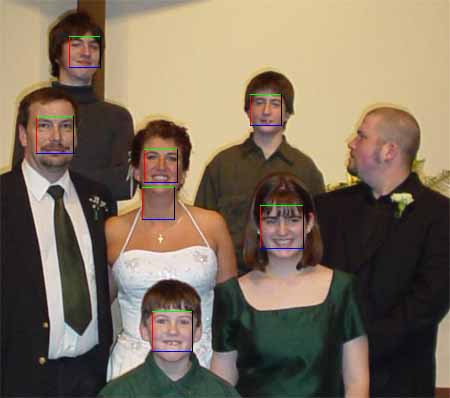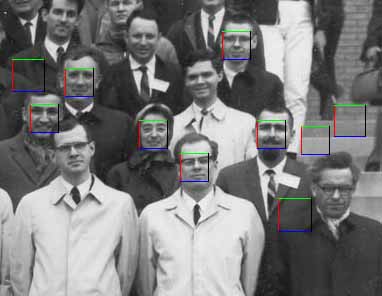Project 4: Eigenfaces
In this project we create a facial recognition system which reduces each facial image to a vector,
then uses Principal Component Analysis to find the space of faces. Below are some results.
Experiments
Testing recognition with cropped class images
Procedure
-
Use the cropped, non-smiling students (in class_nonsmiling_cropped) to compute
7 eigenfaces.
-
Use the same set of images to compute a userbase.
-
Have the program recognize the cropped, smiling student images (in
class_smiling_cropped) in the smiling userbase.
Questions
-
How many faces did the program recognize correctly? Incorrectly?
-
For instances where the program was wrong, what was the
average position of the correct answer in the list of closest matches?
-
Of the three mismatched faces, the average position of the correct
answer was about 4.333.
If you recognize a female face, will the second, third and fourth matches
usually be female? How about for male faces? Give supporting data.
The results do not support a gender preference (to match males
with males or females with females). The second match was almost always of the same
gender, but half of the top five were of the opposite sex.
In a real-life scenario with thousands of users would you use the entire user
set to compute the face space? Why or why not?
-
No. I would initially try to accurately sample the users
to have approximately the correct proportion of males, females, and races as the
expected proportions of the problem I wish to work on. These proportions would change
depending on the purpose of the problem and the location.
Why might it be better to use a face set independent of the user set to compute
the eigenfaces?
The average face and seven eigenfaces constructed.

The average face and twelve eigenfaces constructed.

The three faces mis-matched and the five best matches.



Recognizing the undergraduate faces
Procedure
-
Use the cropped undergraduate students (in ugrads_cropped) to compute 12
eigenfaces.
-
Use the small set of class undergraduate images (in class_ugrads_cropped) to
compute a userbase.
-
Have the program recognize the cropped, non-smiling student images in this
userbase.
-
Repeat your experimentation with 5, 10, 15, and 20 eigenfaces. Remember to
regenerate the userbase each time.
-
Why is it best to use as few eigenfaces as possible while still getting good
results?
-
As the number of eigenfaces increases, the face-like quality of
the eigenfaces decreases (the eigen faces with smaller eigenvalue are simply used
to better refine the space). With eigenfaces which do not have much face-like qualities,
other images which are not faces will more likely fall within the face space (closer to these
extra eigenfaces).
Questions
-
Of the students in the class set who are also in the class undergraduate set,
how many did the program recognize correctly? Incorrectly?
-
In the best case, four students were correctly recognized.
In the other cases, only four of the students showed up in the top five best matches
(infact, the same four which were correctly matched).
-
Are the incorrect identifications reasonable? Do they look similar to the
actual person? Give some example images.
-
Why does the program perform more poorly in this recognition task than the
previous one? Give at least three reasons.
-
The difference in conditions when taking the pictures factors largely
into this. Although the images are normalized before calculations are made, different lighting
conditions will cause different reflections on the skin and eye glasses. Secondly, although not as
much of a problem, the images in the udergraduate set are not aligned as well as those in the
class set and our algorithm is very particular in this way. Finally, and even less important, our class
set is not necessarily representive of the race and gender proportions of the undergraduate set which
influence the eigenfaces computed.
-
How did changing the number of eigenfaces used change your results? What number
worked best?
The five students who looked like everyone else (or the five students that
everyone else looked like).

Cropping the undergraduate faces
-
Use the eigenfaces file computed in the previous problem
-
Use your program to crop at least ten of the uncropped undergraduate images
-
Experiment with min_scale, max_scale, and step parameters to find ones that
work robustly and accurately without taking more than 10 seconds or so to run
on each image
Questions
-
What min_scale, max_scale, and scale step did you end up using?
-
A min_scale of 0.2, max_scale of 0.3, and step of 0.01 gave good
results without taking too much time. Too large of a range took too long, and too small
of a range or too large of a step caused for the program to not find the faces.
-
How many of your crop results look correct (cropped to the same part of the
face as the pre-cropped images)? How many look incorrect?
-
All of the cropped faces looked the same as the pre-cropped images
when the min_scale was 0.1, the max_scale was 0.3, and the step was 0.01, but these took
too long to compute. All except one image was correct when the step was changed to 0.5, four
were incorrect when the step was 0.7. The images looked reasonably well on a min_scale of 0.2,
max_scale of 0.3, and step of 0.01 and this was quick to compute.
-
What is the problem with using a min_scale that is too small?
-
None of the images I tested on were incorrectly cropped due to a min_scale
being too small. But it did take so long that I did not try smaller scales (changing only the min_scale and
keeping the max_scale and the step the same caused the program to scan the image many times even though
small scales are quicker to scan). It is possible that with a scale too small, all of the detail would be lost from
the image and it might end up having a small mse and be considered a face.
Ten cropped images.

Finding faces in a group photo
Procedure
-
Find two group photos, one of family or friends and one from the web of TV or
movie characters, or famous people. Each image should have at least four faces.
-
Use your program to find the faces in the photos (use the crop=false option)
-
Does the program tend to think any non-face items in the image are actually
faces? Give some examples.
-
The program works as well as I could have hoped on the image of
my family. My older brother's head was turned and therefore did not appear face like to the algorithm.
The image with Paul Erdos and other Mathematicians did not turn out as well. Four of the ten I had
hoped for were found and the remaining six "faces" were detected throughout the image, mostly containing
horizontal edges which might correspond to face like features.
Questions
-
Show the results of the face detections
-
What min_scale, max_scale, and scale_step did you use for each image?
-
If there are any errors, explain why the program might have failed and how you
could improve the input or the algorithm to correct this.
Marked family and marked image including Paul Erdos, famous
Mathematician.


Extra Credit
I implemented image warping by simply traveling a given distance in the direction
between the two images. Here are some results. Warped TAS and some other warped classmates



I also implemented verify face which determines whether an image is that of a
given user's image given a magic number, max_reconstructed_mse.
Procedure
-
Use the cropped, non-smiling students to compute 6 eigenfaces.
-
Use the same set of images to compute a userbase.
-
Have the program verify the cropped, smiling student images in the smiling
userbase. Test by verifying each student against his or her smiling face, as
well as each student against a smiling face which is of someone else.
-
Experiment with various thresholds to find the one that gives the fewest false
positives and fewest false negatives
Questions
-
What MSE thresholds did you try? Which one worked best? What search method did
you use to find it?
-
I wrote a function in main called verify faces which
takes a userbase file, an eigenface file, a list of images, and a double
max_reconstructed_mse. Then verify face is ran for every image in the list against
every user in the userbase with the given max_mse. Whenever an image is matched
with a user, the user is printed out under the image's name.
When verifying the cropped, smiling students in class_smiling_cropped, any MSE
threshold I chose worked, even down to 1.0. When I tried it on the class_undergrad_cropped
list none were verified until I tried a threshold of 6000, and then only a few were matched. At
60000 only a few more were matched, but a lot more false postives occurred.
Since I had a function to run all these verifications, it was easy simply to type in different
values for the mse threshold to see what worked best.
-
Using the best MSE threshold, what was the false negative rate? What was the
false positive rate?
-
In a real-life verification scenario, why might it be better to have a low
false positive rate than a low false negative rate?
-
Actually, right now it seems like it might be better to
have a higher false positive rate. I suppose it depends on the situation, but if
we were scanning survelliance videos and there was a userbase of people we
were trying to watch for, it would seem better to incorrectly alarm the security and
have a person check the image and make a verification rather than to miss them
if it wasn't a perfect match.
Then again, perhaps a lot of people look similar enough that the security would be
constantly checking the images and no advantages would be made by having a
program to find and verify faces.






